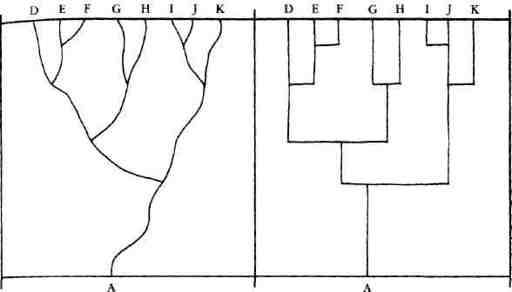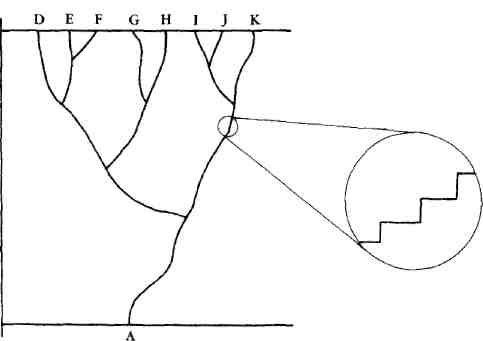Darwin's Dangerous Idea (53 page)
Read Darwin's Dangerous Idea Online
Authors: Daniel C. Dennett

ners. An old Downeast joke makes the same point more succinctly: "Mornin', Edna."
'Mornin', Bessie. How's yer husband?" "Compared to what?"
280 BULLY FOR BRONTOSAURUS
The Spandrel's Thumb
281
same way, Keyser says language—that is, the ability to convey information Elizabeth Vrba and I have proposed that the restrictive and confusing word by speech—may have been a thinking and communicating "spandrel" ac-
"preadaptation" be dropped in favor of the more inclusive term "exapta-cidentally created by the development of some cultural "arch." ... "Lan-tion"—for any organ not evolved under natural selection for its current guage is very likely an accidental artifact of some evolutionary quirk of use—either because it performed a different function in ancestors ( clas-mind."[Robb 1991]
sical preadaptation) or because it represented a nonfunctional part available for later co-optation. [Gould 1991b, p. l44n.]
Perhaps Keyser has been misquoted—I am always cautious about accepting any journalist's account of someone's words, having been burned badly But, according to orthodox Darwinism, every adaptation is one sort of myself—but if the quotation is accurate, then for Keyser spandrels are orig-exaptation or the other—this is trivial, since no function is eternal; if you go inally accidents, not necessities, don't-cares, or QWERTY phenomena. Once, back far enough, you will find that every adaptation has developed out of when I was working at a bronze-casting foundry in Rome, we had an ex-predecessor structures each of which either had some other use or no use at plosion in a cast as we were filling it; molten bronze went splashing all over all. The only phenomena that Gould's exaptation revolution would rule out the floor. One of the splashes hardened into a fantastic lacy shape that I are the phenomena that orthodox adaptationists "quickly" disavowed in any promptly appropriated and turned into a sculpture. Was I exapting a spandrel?
case: planned-for preadaptations.
(The Dadaist artist Marcel Duchamp, in contrast, would not have been The spandrel revolution (against panadaptationism ) and the exaptation exapting a
spandrel
when he appropriated a urinal as his
objet trouve
and revolution ( against preadaptationism ) evaporate on closer inspection, since called it a sculpture, since the urinal had a function in its earlier life.) both panadaptationism and preadaptationism have been routinely shunned by Gould himself (1993a, p. 31) has quoted this newspaper story with ap-Darwinians ever since Darwin himself. These nonrevolutions not only do not proval, not noticing that Keyser has the art history wrong, and not expressing challenge any orthodox Darwinian tenet; the coinages they introduce are as any disagreement with Keyser's definition of a spandrel as an accident. So likely to confuse as the coinages they were supposed to replace.
perhaps Keyser is right about the meaning of the term: spandrels are just It is hard to be a revolutionary if the establishment keeps co-opting you.
accidents available for exaptation. Gould introduced "exaptation" in an article Gould has often complained that his target, neo-Darwinism, recognizes the he co-authored with Elizabeth Vrba in 1982, "Exaptation: A Missing Term in very exceptions he wants to turn into objections, "and this imposes a great the Science of Form." Their intent was to contrast exaptation to adaptation.
frustration upon anyone who would characterize the modern synthesis in Their chief stalking horse, however, was an astonishingly ill-favored term that order to criticize it" (Gould 1980b, p. 130).
had gained some currency in textbooks on evolution:
preadaptation.
The modern synthesis has sometimes been so broadly construed, usually Preadaption seems to imply that the proto-wing, while doing something by defenders who wish to see it as fully adequate to meet and encompass else in its incipient stages, knew where it was going—predestined for a current critiques, that it loses all meaning by including everything.....
later conversion to flight. Textbooks usually introduce the word and then Stebbins and Ayala [two eminent defenders] have tried to win an argument quickly disclaim any odor of foreordination. (But a name is obviously ill-by redefinition. The essence of the modern synthesis must be its Darwinian chosen if it cannot be used without denying its literal meaning.) [Gould core. [Gould 1982a, p. 382.]
1991b, p. 144a]
"Preadaptation" was a terrible term, for exactly the reasons Gould gives, It is surprising to see a Darwinian give anything an essence, but we can but notice that he is not claiming that the targets of his criticism committed take Gould's point, if not his language, there is
something
about the modern the major mistake of granting foresight to natural selection—he admits that synthesis that he wants to overthrow, and before you can overthrow some-they "quickly disclaimed" this heresy in the very act of introducing the term.
thing you must pin it down. He has sometimes claimed (e.g., 1983a) he could They were making the minor mistake of choosing a usage perversely likely to see the modern synthesis doing his work for him, "hardening" into a brittle foster this confusion. Switching from "preadaptation" to "exaptation" might orthodoxy that would be easier to attack. If only! In fact, no sooner has he well be seen, then, as a wise reform of usage, better suited to drive home the gone into battle than the modern synthesis has shown its flexibility, readily orthodox view of adaptationists. Gould, however, resisted this reformist absorbing his punches, to his frustration. I think he is right, however, that the interpretation. He wanted exaptation, and spandrels, to present a "potentially modern synthesis has a "Darwinian core," and I think he is right that it is his fundamental" and "non-Darwinian" alternative.
target; he just hasn't yet put his finger on it himself.
If the case against "pervasive adaptation" has vanished, then, what about

282 BULLY FOR BRONTOSAURUS
Punctuated Equilibrium: A Hopeful Monster
283
the case against gradualism, the other main element in the modern synthesis that Gould sees "breaking down"? Gould's attempted revolution against gradualism was actually his first; it opened with a salvo in 1972 which introduced yet another familiar coinage to the vocabulary of evolutionists and onlookers alike:
punctuated equilibrium.
3. PUNCTUATED EQUILIBRIUM: A HOPEFUL MONSTER
Punctuated equilibrium has finally obtained an unambiguous majority
—
that is, our theory is now 21 years old. We also, with parental pride (and
therefore, potential bias), believe that primary controversy has ceded to
general comprehension and that punctuated equilibrium has been
accepted by most of our colleagues (a more conventional sort of
majority) as a valuable addition to evolutionary theory.
—STEPHEN JAY GOULD and NILES ELDREDGE 1993, p.
FIGURE 10.6
223
A, and that it accomplished the same rightward shift in Design Space in the
What needs to be said now, loud and clear, is the truth: that the theory
same amount of time, but by fits and starts, not a steady climb. (These
of punctuated equilibrium lies firmly within the neo-Darwinian synthe-diagrams can be tricky to think about; the difference between a ramp and a
sis. It always did. It will take time to undo the damage wrought by the
staircase is the point of the contrast, but the giant steps are the
sideways
overblown rhetoric, but it will be undone.
moves, not the vertical bits, which are the boring periods of "motion"
through time only, with no motion through design space.)
—RICHARD DAWKINS 1986a, p. 251
There is a familiar trio of reactions by scientists to a purportedly radical hypothesis: (a) "You must be out of your mind!", (b) "What else is new?
Niles Eldredge and Gould co-authored the paper that introduced the term, Everybody knows
thatV!",
and, later—if the hypothesis is still standing—(c)
"Punctuated Equilibria: An Alternative to Phyletic Gradualism" (1972).
"Hmm. You
might
be on to something!" Sometimes these phases take years Whereas orthodox Darwinians, according to them, tended to envision all ev-to unfold, one after another, but I have seen all three emerge in near olutionary change as gradual, they argued that, on the contrary, it proceeded synchrony in the course of a half-hour's heated discussion following a con-by jerks: long periods of changelessness or
stasis
—equilibrium—interrupted ference paper. In the case of the hypothesis of punctuated equilibrium, the by sudden and dramatic brief periods of rapid change—punctuations. The phases are particularly pronounced, in large part because Gould has several basic idea is often illustrated by contrasting a pair of trees of life (figure 10.6).
times changed his mind about just what he and Eldredge were claiming. In its We can suppose that the horizontal dimension registers some one aspect of first appearance, the thesis of punctuated equilibrium was presented not as a phenotypic variation or body design—we'd need a multidimensional space to revolutionary challenge at all, but as a conservative correction of an illusion represent it all, of course. The orthodox view on the left is pictured as to which orthodox Darwinians had succumbed: paleontologists were simply showing that all motion through design space (that is, to the left or right in the mistaken in thinking that Darwinian natural selection should leave a fossil diagram) is at a more or less steady pace. Punctuated equilibrium, in contrast, record showing lots of intermediate forms.4 There was no shows long periods of unchanged design (the vertical line segments) interrupted by "instantaneous" sideways leaps in design space (the horizontal segments). To see the central claim of their theory, trace the evolutionary 4. "During the past thirty years, the allopatric theory [of speciation] has grown in pop-history of the species at K in each picture. The orthodox picture shows a more ularity to become, for the vast majority of biologists,
the
theory of speciation" (Eldredge or less steady rightward trend from the diagram's Adam species, A. Their and Gould 1972, p. 92). This orthodox theory has some striking implications: "The proposed alternative agrees that K is a descendant of theory of allopatric (or geographic) speciation suggests a different interpretation of

284 BULLY FOR BRONTOSAURUS
Punctuated Equilibrium: A Hopeful Monster
285
mention in the first paper of any radical theory of speciation or mutation. But the most extreme gradualist can allow that evolution could take a breather for later, about 1980, Gould decided that punctuated equilibrium was a a while, letting the vertical lines extend indefinitely through time until some revolutionary idea after all—not an explanation of the lack of gradualism in new selection pressure somehow arose. During this period of stasis, selection the fossil record, but a refutation of Darwinian gradualism itself. This claim pressure would be conservative, keeping the design roughly constant by was advertised as revolutionary—and now it truly was. It was too revolu-swiftly eliminating any experimental alternatives that arose. As the old tionary, and
it
was hooted down with the same sort
of
ferocity the estab-mechanic said, "Don't fix what isn't broke." Whenever a new selection lishment reserves for heretics like Elaine Morgan. Gould backpedaled hard, pressure arose, we'd see a "sudden" response of heightened evolution, a offering repeated denials that he had ever meant anything so outrageous. In punctuation interrupting the equilibrium. Was there really a revolutionary that case, responded the establishment, there is after all nothing new in what point of disagreement being offered by Eldredge and Gould here, or were you say. But wait. Might there be still another reading of the hypothesis, they merely offering an interesting observation about the variability in tempo according to which it is both true and new? There might be. Phase three is of evolutionary processes and its predictable effects on the fossil record?
still under way, and the jury is out, considering several different— but all Punctuationists typically draw the punctuation parts of their revolutionary nonrevolutionary—alternatives. We will have to retrace the phases to see diagrams absolutely horizontal (to make strikingly clear that they are what
the
hue and cry has been about.